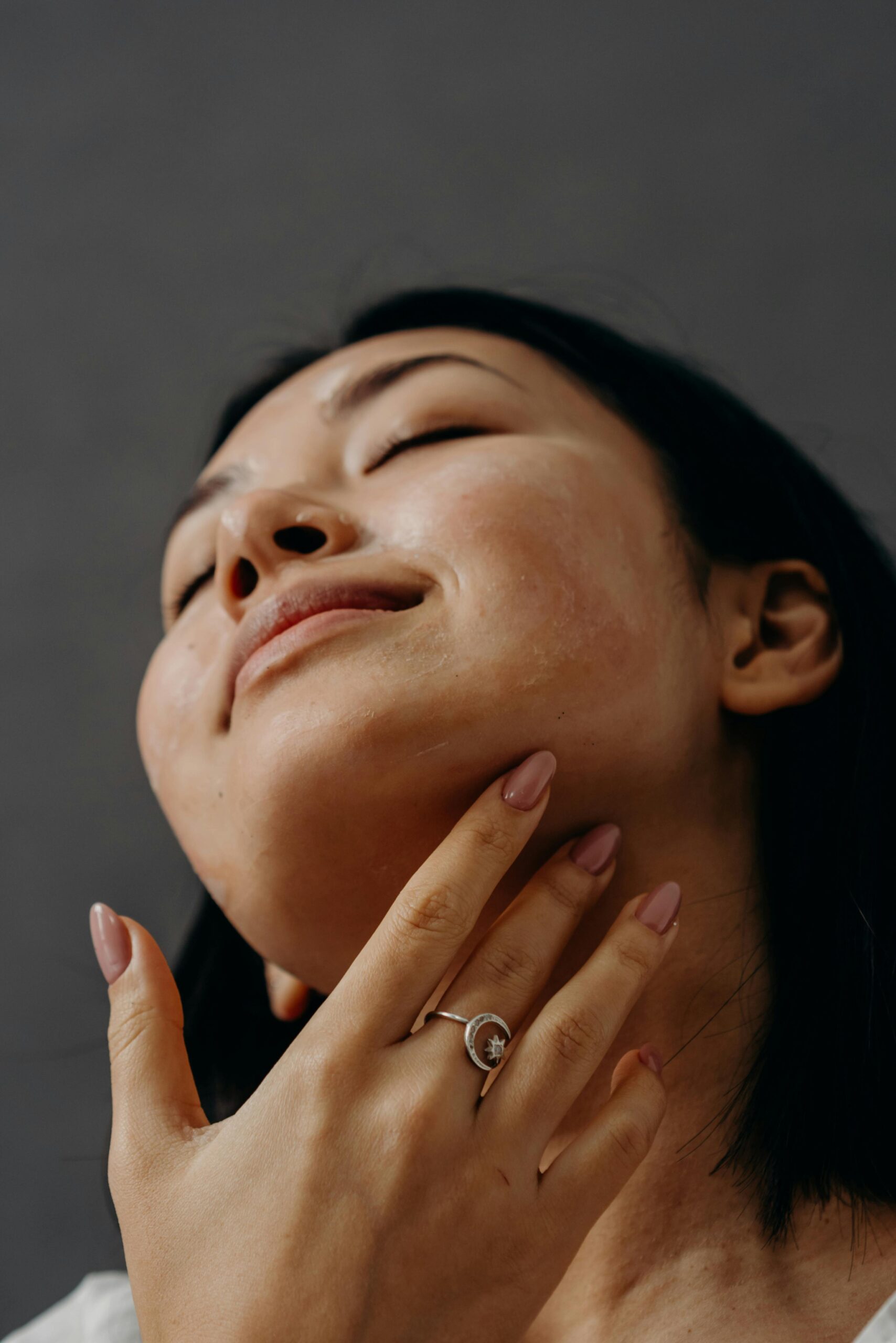Rosacea is a chronic inflammatory skin condition that primarily affects the facial area, characterised by persistent redness, visible blood vessels, and sometimes acne-like breakouts. It is particularly challenging for individuals with combination skin, which typically exhibits both oily and dry areas. This duality can complicate the management of rosacea, as the treatment must address the unique needs of each skin type while also considering the inflammatory nature of the condition.
The central feature of rosacea is its tendency to flare up in response to various triggers, leading to discomfort and self-consciousness for those affected. Combination skin often presents a unique set of challenges when dealing with rosacea. The oily zones, usually found in the T-zone (forehead, nose, and chin), may exacerbate breakouts, while the drier areas can become irritated and sensitive.
This dichotomy necessitates a tailored approach to skincare that balances hydration and oil control without aggravating the rosacea. Understanding the nuances of how rosacea manifests in combination skin is crucial for developing an effective skincare regimen that soothes inflammation while maintaining overall skin health.
Summary
- Rosacea can affect combination skin, leading to redness, irritation, and flare-ups.
- Triggers for rosacea flare-ups can include stress, spicy foods, alcohol, and extreme temperatures.
- When choosing skincare products for combination skin with rosacea, look for gentle, non-comedogenic, and fragrance-free options.
- Implement a gentle cleansing routine using a mild, non-abrasive cleanser to avoid aggravating rosacea symptoms.
- Incorporate anti-inflammatory ingredients like green tea, niacinamide, and licorice root into your skincare routine to help manage redness and irritation.
Identifying Triggers for Rosacea Flare-Ups
Environmental Triggers
Common triggers include environmental factors such as sun exposure, extreme temperatures, and wind, which can lead to increased redness and irritation.
Lifestyle Triggers
Additionally, certain foods and beverages, particularly those that are spicy or contain alcohol, can provoke flare-ups. Stress is another significant contributor; emotional upheaval can lead to heightened skin sensitivity and exacerbate existing symptoms. By keeping a detailed diary of flare-ups, individuals can pinpoint specific triggers and take proactive measures to avoid them.
Skincare Triggers
Moreover, skincare products themselves can be a source of irritation for those with rosacea. Ingredients such as alcohol, fragrances, and harsh exfoliants can worsen symptoms, making it essential to scrutinise product labels carefully. For individuals with combination skin, this means finding products that are gentle enough for sensitive areas while still effective in controlling oil in the T-zone. Understanding these triggers not only aids in preventing flare-ups but also empowers individuals to make informed choices about their skincare and lifestyle.
Choosing the Right Skincare Products for Combination Skin with Rosacea
Selecting appropriate skincare products is vital for managing rosacea in combination skin. The ideal products should be non-comedogenic, fragrance-free, and formulated specifically for sensitive skin. A gentle moisturiser that hydrates without clogging pores is essential; look for formulations containing soothing ingredients like aloe vera or chamomile.
For the oily areas, lightweight gel-based moisturisers can provide hydration without exacerbating oiliness. It is also beneficial to incorporate products with anti-inflammatory properties to help calm redness and irritation. When it comes to cleansing, individuals should opt for mild cleansers that do not strip the skin of its natural oils.
Creamy or lotion-based cleansers are often more suitable for combination skin with rosacea, as they cleanse effectively while maintaining moisture levels. Avoiding foaming cleansers or those containing exfoliating acids is crucial, as these can irritate sensitive areas and trigger flare-ups. By carefully curating a skincare routine that addresses both the oily and dry aspects of combination skin, individuals can create a balanced environment that minimises rosacea symptoms.
Implementing a Gentle Cleansing Routine
A gentle cleansing routine is paramount for anyone dealing with rosacea, particularly those with combination skin. The primary goal of cleansing should be to remove impurities without causing further irritation or stripping the skin’s natural barrier. It is advisable to cleanse twice daily—once in the morning and once before bed—using lukewarm water rather than hot water, which can exacerbate redness.
A soft washcloth or fingers should be used to apply the cleanser gently; vigorous scrubbing can lead to increased inflammation. In addition to choosing the right cleanser, the technique employed during cleansing is equally important. Individuals should take their time, allowing the cleanser to sit on the skin for a minute or two to effectively dissolve makeup and impurities without harsh scrubbing.
Following cleansing, it is beneficial to apply a soothing toner or essence that contains calming ingredients like rose water or witch hazel. This step can help restore pH balance and prepare the skin for subsequent treatments while providing an additional layer of hydration.
Incorporating Anti-Inflammatory Ingredients into Your Skincare Routine
Incorporating anti-inflammatory ingredients into a skincare routine can significantly benefit those with rosacea-prone combination skin. Ingredients such as niacinamide, green tea extract, and azelaic acid are known for their soothing properties and ability to reduce redness and irritation. Niacinamide, in particular, is a versatile ingredient that not only calms inflammation but also helps regulate oil production in the T-zone, making it ideal for combination skin types.
Another powerful anti-inflammatory ingredient is calendula extract, which has been used for centuries for its healing properties. Products containing calendula can help soothe irritated skin while providing hydration without clogging pores. Additionally, incorporating antioxidants like vitamin C can help protect the skin from environmental stressors that may trigger rosacea flare-ups.
By selecting products rich in these beneficial ingredients, individuals can create a skincare routine that actively works to reduce inflammation while addressing the unique needs of combination skin.
Managing Redness and Irritation with Topical Treatments
Prescription Medications
Dermatologists often recommend prescription medications such as topical metronidazole or azelaic acid for their anti-inflammatory properties and ability to reduce redness over time. These treatments can be particularly effective when used consistently as part of a daily skincare routine.
Severe Symptoms
For those with severe symptoms, topical brimonidine may be prescribed; this medication works by constricting blood vessels to reduce redness temporarily. In addition to prescription options, over-the-counter treatments containing soothing ingredients like liquorice root extract or chamomile can provide immediate relief from irritation. These products often come in the form of creams or gels designed specifically for sensitive skin types.
Application and Approach
When applying topical treatments, it is essential to do so gently and avoid layering too many products at once, as this can overwhelm the skin and lead to further irritation. A targeted approach ensures that each product serves a purpose without exacerbating rosacea symptoms.
Seeking Professional Treatment Options for Severe Rosacea
For individuals experiencing severe rosacea that does not respond adequately to at-home treatments, seeking professional help from a dermatologist is advisable. Dermatologists can offer a range of treatment options tailored to individual needs, including laser therapy and intense pulsed light (IPL) treatments. These procedures target visible blood vessels and redness by using specific wavelengths of light to reduce inflammation and improve overall skin tone.
In some cases, oral medications may be prescribed alongside topical treatments for more severe cases of rosacea. Antibiotics such as doxycycline can help reduce inflammation and control breakouts associated with rosacea flare-ups. Additionally, dermatologists may recommend lifestyle modifications or dietary changes based on individual triggers identified during consultations.
By working closely with a professional, individuals can develop a comprehensive treatment plan that addresses both immediate concerns and long-term management strategies.
Lifestyle Changes to Support Rosacea Management
Lifestyle changes play an integral role in managing rosacea effectively alongside skincare routines and professional treatments. One of the most impactful changes involves adopting a balanced diet rich in anti-inflammatory foods such as fruits, vegetables, whole grains, and healthy fats like omega-3 fatty acids found in fish and flaxseeds. These dietary choices can help reduce systemic inflammation and support overall skin health.
Stress management techniques are equally important; practices such as yoga, meditation, or regular exercise can significantly lower stress levels and contribute to improved skin conditions. Additionally, avoiding known triggers—such as excessive sun exposure—by wearing broad-spectrum sunscreen daily is crucial for protecting sensitive skin from harmful UV rays. By integrating these lifestyle changes into daily routines, individuals with rosacea can create a supportive environment that promotes healing while minimising flare-ups associated with combination skin challenges.
If you are looking for sustainable skincare options for your eco-conscious beauty routine, you should check out the article on Green Beauty: The Ultimate Guide to Sustainable Skincare for Eco-Conscious Beauty Enthusiasts. It provides valuable insights into how to make environmentally friendly choices when it comes to your skincare products. In addition, if you are struggling with rosacea like many individuals with combination skin, you may find the article on How to Deal with Rosacea: Tips and Treatments helpful in managing your condition effectively.




